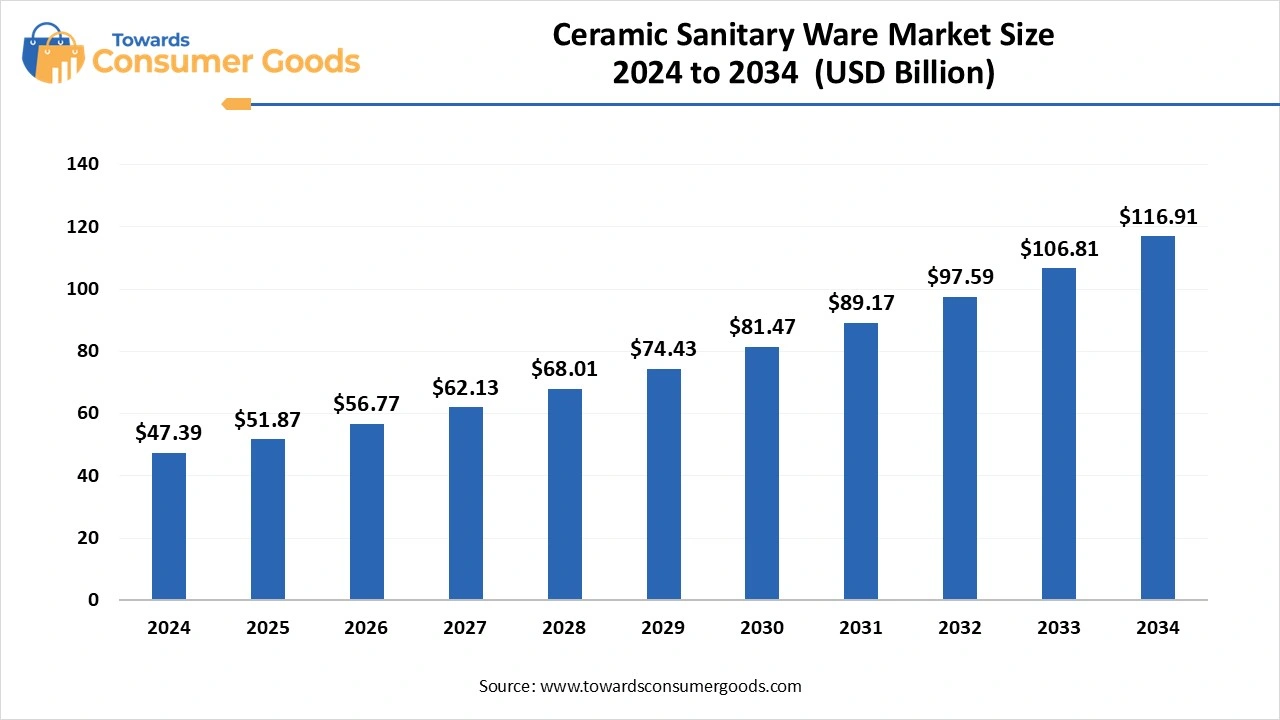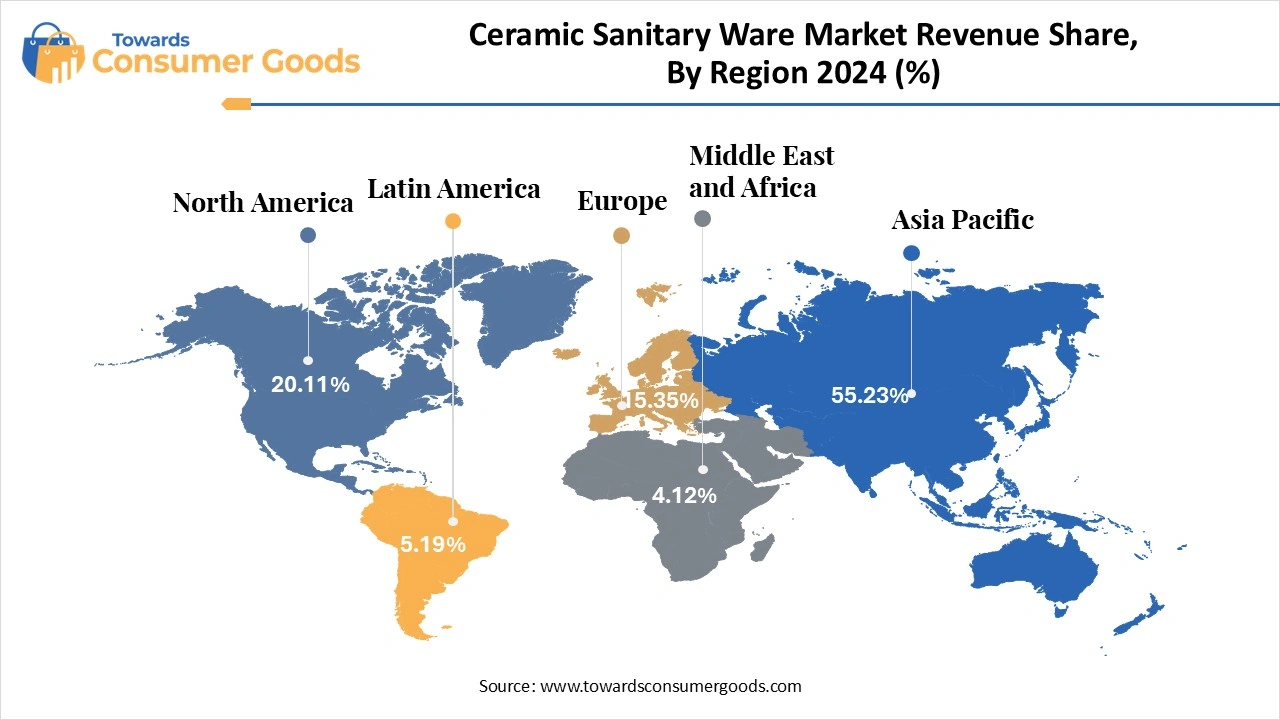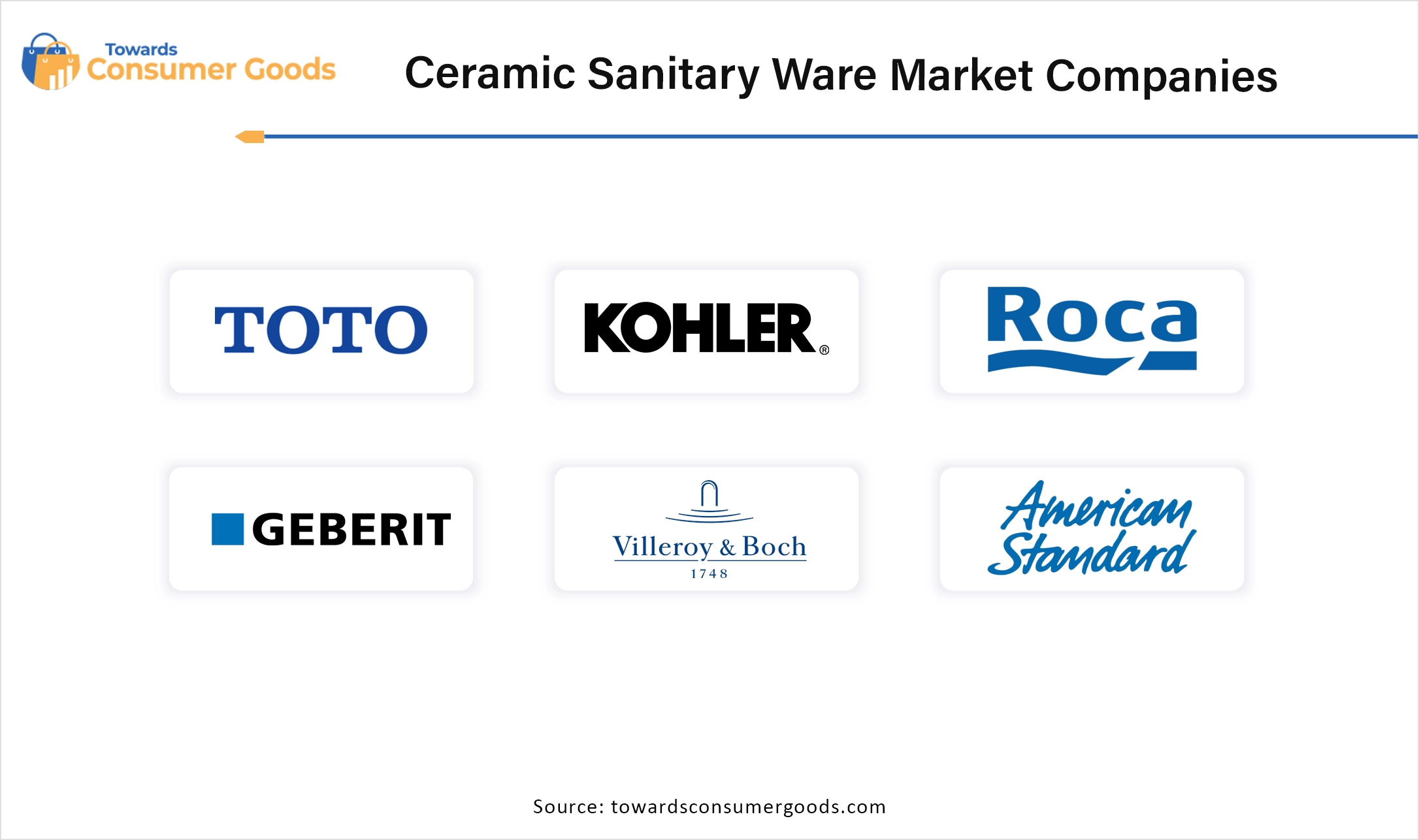April 2025
The global ceramic sanitary ware market size is calculated at USD 47.39 billion in 2024, grew to USD 51.87 billion in 2025, and is projected to reach around USD 116.91 billion by 2034. The market is expanding at a CAGR of 9.45% between 2025 and 2034. The shift towards urbanization and the rising construction sector in the region increases the demand for the market and helps in expansion.

Ceramic sanitary ware includes a variety of essential bathroom fixtures such as toilets, wash basins, bathtubs, and sinks. These products are in high demand for their durability, ease of cleaning, resistance to chemicals and scratches, and overall cost-effectiveness. These qualities make them highly suitable for both residential and commercial use. The growing population and rapid urbanization have led to an increase in the construction of single-family homes, which in turn has driven the demand for sanitary ware in new housing projects.
On the commercial side, the expansion of the IT industry in countries like India and China, along with ongoing infrastructure development, evolving lifestyles, and the growth of private office spaces, is contributing significantly to market growth. Additionally, continuous technological advancements in sanitary products and the increasing trend of home renovations are expected to further increase demand for ceramic sanitary ware in the forecasted period.
The ceramic sanitary ware market is driven by several key factors contributing to its steady growth. Rapid urbanization and infrastructure development, especially in emerging economies, are increasing the demand for modern sanitation facilities. Rising hygiene awareness, supported by government initiatives, is encouraging the adoption of quality sanitary products. Additionally, growing disposable incomes are leading consumers to invest in appealing and premium bathroom solutions.
Technological advancements, including touchless and smart sanitary ware, are also transforming user experiences. Furthermore, the increasing focus on sustainability and water conservation is pushing manufacturers to innovate eco-friendly products, which drives the growth of the market and helps in the expansion of the market.
| Report Attributes | Details |
| Market Size in 2025 | USD 51.87 Billion |
| Expected Size in 2034 | USD 116.91 Billion |
| Growth Rate | CAGR of 9.45% from 2025 to 2034 |
| Base Year of Estimation | 2024 |
| Forecast Period | 2025-2034 |
| High Impact Region | Asia Pacific |
| Segment Covered | By Product, By Application, By Region |
| Key Companies Profiled | Geberit Group (Switzerland), Kohler Co (U.S.),TOTO Ltd. (Japan),LIXIL Group Corporation (Japan),Roca Sanitario SA (Spain),Villeroy & Boch AG (Germany), RAK Ceramics (UAE),Duravit AG (Germany),Duratex SA (Brazil), HSIL (India),Orient Ceramics (India),Golf Ceramics Ltd (India) |
Smart sanitary ware adoption is rapidly transforming the bathroom experience, driven by advancements in technology and rising consumer demand for convenience, hygiene, and luxury. Products like sensor-based faucets, automatic flushing systems, heated toilet seats, and smart toilets with health monitoring features are gaining popularity, especially in urban and premium segments. These innovations offer hands-free operation, water conservation, and improved sanitation, appealing to both residential and commercial users.
The integration of IoT in sanitary ware is also enabling remote control and real-time usage data. As smart homes become more mainstream, the demand for intelligent bathroom solutions is expected to grow significantly, resulting in creating an opportunity for the ceramic sanitary ware market.
High production costs are a significant challenge in the ceramic sanitary ware industry. The manufacturing process involves energy-intensive steps such as molding, drying, glazing, and firing at high temperatures, which contribute to high energy consumption and operating expenses. Additionally, the cost of essential raw materials like clay, silica, and feldspar has been volatile, which further impacts the final cost of the product.
The need for skilled labor and quality control adds to production costs. These high costs can make it difficult for manufacturers, especially small and medium enterprises, which is a challenge for the growth of the ceramic sanitary ware market.
Asia Pacific dominated the ceramic sanitary ware market in 2024. The Asia Pacific region dominates the market due to rapid urbanization, population growth, and strong construction activity. The demand for residential and commercial properties has surged, especially in emerging economies, boosting the need for modern and hygienic bathroom solutions.
Smart city projects and industrial development in the region also boost the growth of the market. Government initiatives aimed at improving sanitation infrastructure in the region, like public toilets, with increasing population in the country, and due to new initiatives and policies, and rising middle-class income levels, are further accelerating market growth.
India is a leading and key growth driver in the region. The Indian government’s “Swachh Bharat Abhiyan” has significantly increased sanitation coverage, especially in rural areas. In urban India, rising disposable incomes and a shift toward premium and designer sanitary ware products are creating new market opportunities. The real estate and hospitality sectors are also contributing to this growth. China is also another major contributor, benefiting from its massive construction and real estate sectors in the country. Smart city projects and industrial development zones have increased the demand for modern sanitation infrastructure.
Chinese manufacturers are also investing in automation and exporting competitively priced products globally. Overall, the Asia Pacific region is expected to maintain its leading position in the market, supported by economic growth, government support, and evolving consumer preferences across key countries like India, China, and Southeast Asian nations. This drives the growth of the ceramic sanitary ware market.

North American is expected to grow in the ceramic sanitary ware market in the forecasted period. North America holds a significant share in the market, the growth is driven by a strong demand for high-end, technologically advanced, and aesthetically appealing bathroom products.
The region also benefits from a well-established infrastructure, high disposable incomes, and a mature real estate market that consistently invests in renovation and remodelling activities. Growing awareness about water conservation and sustainability has also influenced consumer preferences, leading to the adoption of eco-friendly and smart sanitary solutions, which increases the demand and helps the market to grow in the forecasted period.
The United States is the largest contributor to the North American market. The U.S. market is experiencing growth due to increased residential and commercial construction, especially in urban areas. There is a strong trend toward bathroom upgrades that feature smart technology, such as sensor-operated faucets and toilets, which offer improved hygiene and convenience. Moreover, the rise in green building certifications like LEED is encouraging the use of water-saving and sustainable sanitary ware.
Additionally, the growing hospitality and healthcare sectors are fueling demand for high-performance sanitary products. With an emphasis on design, hygiene, and innovation, North America, particularly the U.S., continues to present lucrative opportunities for ceramic sanitary ware manufacturers, especially those offering smart and environmentally responsible solutions drive the growth of the ceramic sanitary ware market.
The toilet sinks and water closets segment led the ceramic sanitary ware market in 2024. The toilet sinks and water closets segment represents one of the most important and high-demand areas in the market. These products are essential components in residential, commercial, and public toilets, contributing significantly to overall market revenue. The segment is experiencing strong growth due to increased awareness of hygiene and sanitation, as well as rising living standards in developing economies. Advancements in product design, such as rimless toilets, wall-mounted water closets, and compact designs, are gaining popularity for their space-saving and easy-to-clean features.
Additionally, the trend toward smart toilets is reshaping the segment, especially in developed markets like the U.S., Japan, and South Korea. Features like automatic flushing, seat warmers, bidet functions, and sensor technology are being increasingly integrated. Governments promoting water-saving toilets through regulations and certifications are also boosting demand for efficient models. As consumers seek comfort, hygiene, and modern aesthetics, this segment is expected to witness continuous innovation and expansion, which drives the market growth.
The urinals segment expects significant growth in the ceramic sanitary ware market during the forecast period. The urinals segment plays a crucial role in the commercial and institutional sectors of the market. Primarily used in public restrooms, office buildings, schools, malls, airports, and hospitality venues, urinals offer a space-efficient and hygienic solution for male sanitation needs. This segment is driven by increasing urban infrastructure development and a growing emphasis on maintaining hygienic public sanitation facilities.
Waterless and sensor-based urinals are gaining traction due to their water-saving capabilities and touchless operation, which enhances hygiene and reduces the spread of germs. In developed regions such as North America and Europe, smart urinals with automated flushing systems are becoming common, aligning with the broader trend of touch-free sanitary solutions. Meanwhile, in developing countries, rapid urbanization and government investments in public health infrastructure are accelerating the installation of urinals in new and renovated buildings. With environmental concerns and hygiene awareness on the rise, the urinals segment is poised for steady growth, especially in large-scale commercial and institutional projects.
The residential segment dominated the ceramic sanitary ware market in 2024. The residential segment is a major contributor to the market, driven by rising urbanization, increased home ownership, and growing consumer awareness of hygiene and bathroom aesthetics. As living standards improve, especially in emerging economies, homeowners are investing more in modern and comfortable bathroom solutions.
This segment includes a wide range of products such as toilets, wash basins, bathtubs, and bidets, with a strong focus on durability, water efficiency, and design appeal. In developing countries like India and China, government initiatives such as housing for all and sanitation programs have significantly boosted demand in the affordable housing sector.
In contrast, developed markets like the U.S., Japan, and parts of Europe are witnessing strong demand for premium and smart sanitary ware as part of home renovation and remodelling trends. Consumers are also leaning toward minimalistic and space-saving designs, eco-friendly options, and sensor-enabled products that enhance convenience and hygiene. As the demand for personalized and luxurious home spaces grows, the residential segment is expected to see sustained and dynamic expansion in the ceramic sanitary ware market.
The commercial segment expects significant growth in the ceramic sanitary ware market during the forecast period. The commercial segment of the market includes products used in public and business facilities such as offices, hotels, malls, airports, hospitals, and schools. This segment is characterized by high demand for durable, functional, and hygienic solutions to accommodate large foot traffic in restrooms.
With the rise in urbanization and commercial real estate development, the demand for quality sanitary ware in commercial spaces has increased significantly. This trend is particularly evident in the hospitality and healthcare industries, where the need for clean and modern facilities is a priority. In addition to functionality, aesthetics and sustainability have become important factors in commercial buildings, especially in high-end hotels, offices, and luxury developments. Features like water-saving toilets, touchless faucets, and hands-free urinals are gaining popularity due to their hygiene benefits and lower maintenance costs.
Furthermore, the growing focus on LEED-certified buildings and eco-friendly construction practices has driven demand for water-efficient and energy-saving products. As the commercial construction sector continues to expand, this segment is expected to grow steadily, fueled by technological advancements and sustainability trends, which results in the growth of the ceramic sanitary ware market in the forecasted period.

By Product
By Application
By Regional
April 2025
April 2025